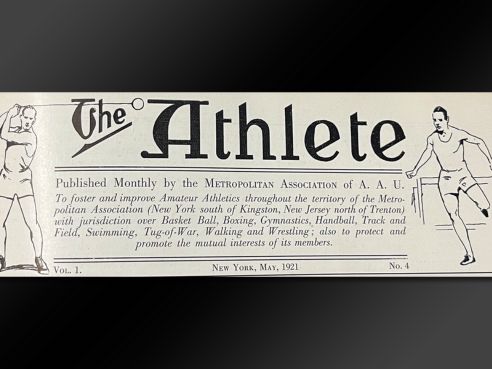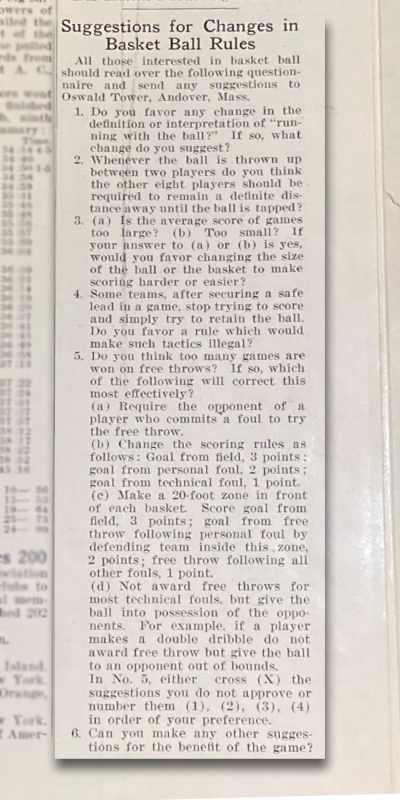Past Meeting Present: Basketball's Growth Viewed from a 102-Year-Old Newsletter Column
11/17/2023
A newsletter column from 1921 shows how far basketball has come, and how long some ideas have been around.
By: Alexander Gagnon
ORLANDO, Fla. (November 15, 2023)- Basketball has evolved and changed countless times over the past 132 years. From the games’ humble origins in a YMCA gym in the early 1890s to being one of the most popular sports in today’s world, the game is a far cry from the 13 original rules that James Naismith outlined. An example: it took 6 years before dribbling the ball became a part of the game in any capacity, and now it is the most fundamental element of moving the ball up and down the court.
By the time the 1920s rolled around, the sport was starting to become a hit with fans across the country, especially at the amateur level. But in this time of growth for the sport, everyone had different ideas on how to improve the game. Some had ideas for how scoring should be changed, or the pace of the game, or how free throws were awarded.
In a cool bit of history, check out this column from the AAU Metropolitan District’s “Amateur Athlete” publication. Issued over 102 years ago in May 1921, the anonymous author is pitching some new ideas for the sport of basketball. Or “Basket Ball” as it was referred to then. Any suggestions were to be mailed to Oswald Tower, who would eventually be a member of the inaugural induction class of the Basketball Hall of Fame.
A transcript of the column is below, an image of the column can be found at the end of the article.
Suggestions for Changes in Basket Ball Rules
All those interested in basket ball should read over the following quesitonaire and send any suggestions to Oswald Tower, Andover, Mass.
1.Do you favor any change in the definition or interpretation of “running with the ball?” If so, what change do you suggest?
2.Whenever the ball is throw up between two players do you think the other eight players should be required to remain a distance away until the ball is tapped?
3.(a) Is the average score of games too large? (b) Too small? If your answer to (a) or (b) is yes, would you favor changing the size of the ball or the basket to make scoring easier or harder?
4.Some teams, after securing a safe lead in a game, stop trying to score and simply try to retain the ball. Do you favor a rule which would make such tactics illegal?
5.Do you think too many games are won on free throws? If so, which of the following will correct this most effectively? (a) Require the opponent of a player who commits a foul to try the free throw. (b) Change the scoring rules as follows: Goal from field, 3 points; Goal from personal foul, 2 points; Goal from technical foul, 1 point. (c) Make a 20-foot zone in front of each basket. Score goal from field, 3 points; goal from free throw following personal foul by defending team in this zone, 2 points; free throw following all other fouls, 1 point. (d) Not award free throws for most technical fouls, but give the ball into possession of the opponents. For example, if a player makes a double dribble do not award free throw but give the ball to an opponent out of bounds.
In No. 5, either cross (X) the suggestions you do not approve or number them (1), (2), (3), (4) in order of your preference.
There is a surprising amount of cross over between ideas mentioned in this questionnaire and things we see in today’s game.
The fourth question inquires about the removal of stalling tactics from the game. An idea that over time has been eliminated through the addition of the backcourt violation and a shot clock when on offense.
In the fifth question, the core of the idea is changing how often we see free throws in a game. In 1921, free throws had far higher prominence in determining the outcome of a game than today as scoring was significantly lower than it is today. However, the third suggestion here draws a striking similarity to what we see today. A 3-point arc, an inside zone worth 2 points, and a free throw that in some instances count as 1 point.
But for all the similarities, there are some interesting differences, too, such as the proposal in the third question if scoring was too high or too low. For some context, the 1924 National AAU Basketball Championship saw Butler College defeat the Kansas City Athletic Club 30-26. That’s a combined 56 points for the two finalists, less than a quarter of an average NBA game from the 2022-23 season, which typically showed fans a combined 229.4 points per game. It becomes clear which of those ideas won over time.
At the end of the day, this is a long-forgotten column in a newsletter that likely has not seen the light of day in decades. But within the lines of this questionnaire, we find a glimpse of what people saw the future of this game to be. Not all of them are correct, how could they be? But you can see even then there was a vision for how the game could grow. A growth that we continue to try and build on here at the AAU.
Like any great work, basketball is not completed. It will continue to evolve and grow, and over 100 years from now not only will basketball continue to flourish, but something tells me it will look just as different to us as our game today would to those in 1921. But one thing that will be a common thread in all those times -- from 1921, 2023, or the year 2125 – is what basketball means to people: its ability to unite community, promote physical activity, and be a platform to showcase some of the most talented and dedicated athletes on the planet. Regardless of if they are professionals, amateurs, or kids that participate in AAU tournaments.
And after 100 years as the sport continues to evolve, I hope those in the future can look back to this time with the same curiosity as we have when looking at this old newsletter of a long-gone time. An appreciation of the past vision and an excitement for the future’s development.

ORLANDO, Fla. (November 15, 2023)- Basketball has evolved and changed countless times over the past 132 years. From the games’ humble origins in a YMCA gym in the early 1890s to being one of the most popular sports in today’s world, the game is a far cry from the 13 original rules that James Naismith outlined. An example: it took 6 years before dribbling the ball became a part of the game in any capacity, and now it is the most fundamental element of moving the ball up and down the court.
By the time the 1920s rolled around, the sport was starting to become a hit with fans across the country, especially at the amateur level. But in this time of growth for the sport, everyone had different ideas on how to improve the game. Some had ideas for how scoring should be changed, or the pace of the game, or how free throws were awarded.
In a cool bit of history, check out this column from the AAU Metropolitan District’s “Amateur Athlete” publication. Issued over 102 years ago in May 1921, the anonymous author is pitching some new ideas for the sport of basketball. Or “Basket Ball” as it was referred to then. Any suggestions were to be mailed to Oswald Tower, who would eventually be a member of the inaugural induction class of the Basketball Hall of Fame.
A transcript of the column is below, an image of the column can be found at the end of the article.
Suggestions for Changes in Basket Ball Rules
All those interested in basket ball should read over the following quesitonaire and send any suggestions to Oswald Tower, Andover, Mass.
1.Do you favor any change in the definition or interpretation of “running with the ball?” If so, what change do you suggest?
2.Whenever the ball is throw up between two players do you think the other eight players should be required to remain a distance away until the ball is tapped?
3.(a) Is the average score of games too large? (b) Too small? If your answer to (a) or (b) is yes, would you favor changing the size of the ball or the basket to make scoring easier or harder?
4.Some teams, after securing a safe lead in a game, stop trying to score and simply try to retain the ball. Do you favor a rule which would make such tactics illegal?
5.Do you think too many games are won on free throws? If so, which of the following will correct this most effectively? (a) Require the opponent of a player who commits a foul to try the free throw. (b) Change the scoring rules as follows: Goal from field, 3 points; Goal from personal foul, 2 points; Goal from technical foul, 1 point. (c) Make a 20-foot zone in front of each basket. Score goal from field, 3 points; goal from free throw following personal foul by defending team in this zone, 2 points; free throw following all other fouls, 1 point. (d) Not award free throws for most technical fouls, but give the ball into possession of the opponents. For example, if a player makes a double dribble do not award free throw but give the ball to an opponent out of bounds.
In No. 5, either cross (X) the suggestions you do not approve or number them (1), (2), (3), (4) in order of your preference.
There is a surprising amount of cross over between ideas mentioned in this questionnaire and things we see in today’s game.
The fourth question inquires about the removal of stalling tactics from the game. An idea that over time has been eliminated through the addition of the backcourt violation and a shot clock when on offense.
In the fifth question, the core of the idea is changing how often we see free throws in a game. In 1921, free throws had far higher prominence in determining the outcome of a game than today as scoring was significantly lower than it is today. However, the third suggestion here draws a striking similarity to what we see today. A 3-point arc, an inside zone worth 2 points, and a free throw that in some instances count as 1 point.
But for all the similarities, there are some interesting differences, too, such as the proposal in the third question if scoring was too high or too low. For some context, the 1924 National AAU Basketball Championship saw Butler College defeat the Kansas City Athletic Club 30-26. That’s a combined 56 points for the two finalists, less than a quarter of an average NBA game from the 2022-23 season, which typically showed fans a combined 229.4 points per game. It becomes clear which of those ideas won over time.
At the end of the day, this is a long-forgotten column in a newsletter that likely has not seen the light of day in decades. But within the lines of this questionnaire, we find a glimpse of what people saw the future of this game to be. Not all of them are correct, how could they be? But you can see even then there was a vision for how the game could grow. A growth that we continue to try and build on here at the AAU.
Like any great work, basketball is not completed. It will continue to evolve and grow, and over 100 years from now not only will basketball continue to flourish, but something tells me it will look just as different to us as our game today would to those in 1921. But one thing that will be a common thread in all those times -- from 1921, 2023, or the year 2125 – is what basketball means to people: its ability to unite community, promote physical activity, and be a platform to showcase some of the most talented and dedicated athletes on the planet. Regardless of if they are professionals, amateurs, or kids that participate in AAU tournaments.
And after 100 years as the sport continues to evolve, I hope those in the future can look back to this time with the same curiosity as we have when looking at this old newsletter of a long-gone time. An appreciation of the past vision and an excitement for the future’s development.

 Email
Email Print
Print









